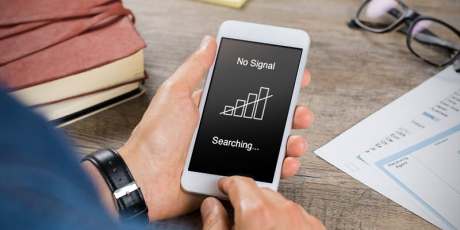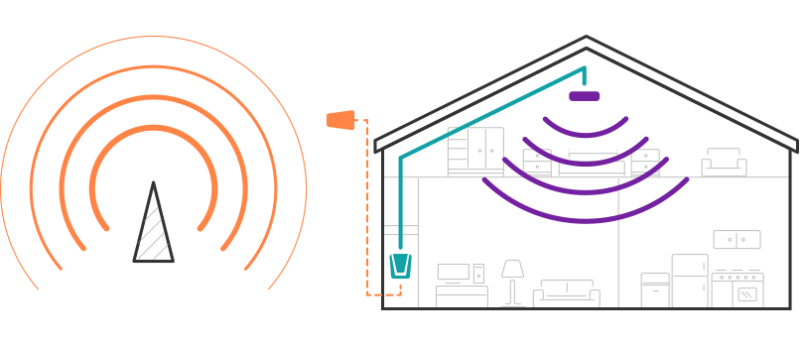How Does Mobile Phone Signal Booster Work? 5 Points You should know
Author: Mark Russell Date: 28th Mar 2022

What is a cell phone signal booster? How do cell phone boosters work? Reasonable questions. These devices have not been without controversy, but there do exist legitimate, legal cell phone signal boosters that prevent dropped calls, weak signal, and interrupted mobile communications. For those familiar with no signal frustrations, the critical concern is: do cell phone signal boosters really work? We’re here to answer that question. By carefully reviewing each element involved and breaking them into it into five key points, we hope to show how and why cell phone boosters are a solution to your cell signal problems.
 How Do Cell Phone Boosters Work?
How Do Cell Phone Boosters Work?
Cell phone signal boosters work to enhance the coverage of existing signal, allowing your mobile phone to have better reception and service for both inbound and outbound communications. They are made of three key parts: first, the outside antenna, which captures the existing signal; second, the amplifier, which boosts it; last, the inside antenna, responsible for broadcasting the amplified signal to your phone.
If you’ve wondered whether a cell phone booster is legal, the answer is yes: a hundred percent. The US Federal Communications Commission set up guidelines for signal boosters in early 2013. These were intended to improve the quality of calls and messages in rural territories or buildings that make signal transmission difficult. As a general rule, all sellers must offer cell boosters with the three elements mentioned above and within certain guidelines. Reputable sellers will not stock cell phone signal boosters that exceed these guidelines.
What elements make a cell phone signal booster work?
1. Decibels: Measures Signal Strength
2. The Donor Antenna: Brings Signal Inside
3. The Amplifier: A Bridge to Better Signal
4. The Inside Antenna: Broadcasts Signal to Your Phone
5. Single and Multi-Carrier Signal Boosters: last but not least
If you’ve experienced slow data speeds or dropped calls with family or colleagues who are miles away from you -and the cell tower distance doesn’t help either-, then the following points will teach us why cell phone boosters are the appropriate solution.
1. Decibels Measure Signal Strength
Decibels are the international standard unit used to measure signal strength. Those bars that appear on the phone screen are your phone’s indicator of how powerful the signal is.
When translating from bars to decibels (as we explained in our post on how to boost cell signal), -50 dB generally equals full bars on most phones. A no signal area is -120 dB. Most people eke out existence somewhere between the two, and the closer you are to -120 dB, the more likely you’ll have slow internet and dropped calls. In other words, the goal is to get your decibel level as close to -50 dB as possible. Signal boosters provide boosts as large as +25 dB, transforming near dead zones into good signal areas.
Depending on aspects like location, distance from cell towers, or whether you’re in a house, vehicle, or commercial building, the gain of decibels will varyt. One thing to consider is that decibels and radiation are two different concepts. The levels of radiation from boosters in the US can’t exceed the level that your phone produces, and there is no scientific research that proves that cell radiation is linked to health issues.
2. Donor Antenna: Bring Existing Signal Inside
Donor antennas, colloquially known as outside antennas, receive the external signal from cell phone towers. Antennas are either omnidirectional or unidirectional, and the difference lies in the degree from which they catch signal: up to 90° for directional antennas, or 360° in the case of omnidirectional antennas. There is no best or worst option; the type of antenna that suits you the most depends on your specific needs and the situation surrounding you.
Currently, almost all the antennas support either 3G or 4G broadband cellular networks. In the case of the brand new 5G broadband, it’s being tested by carriers in some areas of the US, and a small number of signal boosters can now improve 5G networks, depending on the location and type of usage (e.g., commercial or familiar purposes). However, most cannot, as 5G standards are so wildly different from the traditional 4G, 4G LTE, or 3G technologies. 4G and 4G LTE are estimated to last quite awhile as the main source of cellular data and voice.
3. The Amplifier: A Bridge to Better Signal
The amplifier, also called the booster, does the legwork. It receives the weak signal from the outside antenna and amplifies it, based on its specifications, to decibel levels that ensure you have better mobile network connectivity inside your home or vehicle. The important thing to know about from amplifiers have to do with the scope of boosting that they can achieve.
Usually, amplifiers come with a scope range from 500 to 7500 sq ft. However, the most extended scope doesn’t always mean the most appropriate one to your current situation. If you only struggle with a poor network in your room at home, then a booster with a coverage of up to 1500 should be enough. But if the problem is at your office or your house in general, other amplifiers should be considered.
4. The Inside Antenna: Broadcasts Signal to Your Phone
This is the final step in showing how cell phone boosters work to improve quality in your communications. The inside antenna broadcasts the augmented signal towards your phone. They work just as outside antennas do, but instead of receiving the signal, they spread it across their scope.
Most signal booster kits can use two different types of indoor antennas: the dome antenna and the panel antenna. If you aim to cover just one specific area or room, you might want to consider a booster with a panel antenna included. However, if you seek to boost the signal on one floor of a building, then a dome antenna is a good option. Our support team at SignalBoosters.com can assess your current needs and will advise you on what type of booster would work best for you.
5. Single and Multi-Carrier Signal Boosters
On top of the key elements that make a cell phone booster work, one last thing ensures correct operation. Before acquiring a brand-new kit, make sure it will support your carrier’s network. How? Most of the manufactures include multi-carriers kits, and they are able to amplify any North American carrier bandwidth so that you don’t need to think twice before switching from one carrier to another.
There are also single-carrier boosters. These are capable of boosting a specific mobile network to a greater extend than a multi-carrier unit, since the amplifier is set up to one carrier’s specific bandwidths. Once again, the effective booster will be the one who suits your needs the most. Which brings us to our last consideration:
When is a Cell Phone Signal Booster Useful?
Imagine a farm in the middle of a quiet valley. In the context of our frenetic society, this is a dream come true – until we realize the closest cell tower is not actually close enough to provide adequate cell signal. For some, living in a rural area is like paradise, even moreso when you have the proper tools for a long-term stay.
Sometimes we don’t need to go farther than our bedroom which, coincidentally, is the most isolated room in our home. Do your bars instantly drop to nothing once you walk in? Or how about when driving on your not-so-favorite interstate highway?
In short, they’re useful if you find yourself indoor with spotty signal. They can literally bring open up the world to you if
These are the five key elements which allow cell phone signal boosters to work, but don’t hesitate to contact our experts for guidance, whether that is to find the best option for your situation, or to answer any further questions you may have.
If this article “How Does Mobile Phone Signal Booster Work? 5 Points You should know” is helpful, you can share with your friends.
Related Article
-
Mobile Signal Booster – How does it work?
The fundamental function of a mobile signal Booster is to convert weak signals into strong signals and send them to the user’s phone. Its configuration requires an external antenna, booster, internal […]
-
Bad mobile signal and solutions to Fix Them
Drops of calls during this time would break the hearts of many. If this happens consistently, it would be a great idea to find out the reasons for poor cellular reception. Above all, it is because there is […]
-
How To Improve Mobile Signal Strength At Home?
Different network providers provide mobile phone plans, deals, and home internet services. These companies include; Verizon, T-Mobile, AT&T Internet, T-Mobile Home Internet, and many more […]
